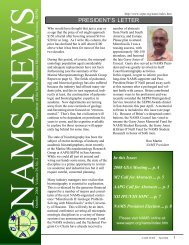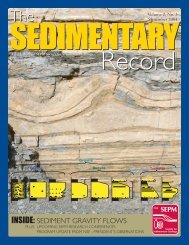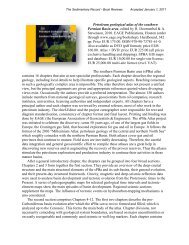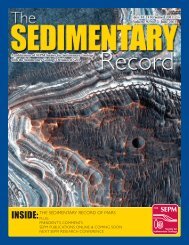PDF of contents and abstracts - SEPM
PDF of contents and abstracts - SEPM
PDF of contents and abstracts - SEPM
Create successful ePaper yourself
Turn your PDF publications into a flip-book with our unique Google optimized e-Paper software.
MULTIANALYTICAL PEDOSYSTEM APPROACH TO CHARACTERIZING<br />
AND INTERPRETING THE FOSSIL RECORD OF SOILS<br />
LEE C. NORDT<br />
Department <strong>of</strong> Geology, Baylor University, One Bear Place #97354, Waco, Texas 76798, USA<br />
e-mail: Lee_Nordt@baylor.edu<br />
CHARLES T. HALLMARK<br />
Department <strong>of</strong> Soil <strong>and</strong> Crop Sciences, Texas A&M University, 370 Olsen Blvd., College<br />
Station, Texas 77843, USA<br />
STEVEN G. DRIESE AND STEPHEN I. DWORKIN<br />
Department <strong>of</strong> Geology, Baylor University, One Bear Place #97354, Waco, Texas 76798, USA<br />
ABSTRACT: Interpretations <strong>of</strong> critical zones, past <strong>and</strong> present, are dependent on the comprehensive<br />
characterization <strong>of</strong> morphological, physical, chemical, biological, <strong>and</strong> mineralogical properties <strong>of</strong> soils as<br />
the biogeochemical mediator <strong>of</strong> Earth’s surface processes. The traditional approach <strong>of</strong> studying fossil<br />
soils (paleosols), however, is modeled after methods developed during the advent <strong>of</strong> pedology in the early<br />
20th century. Even though there have been remarkable advances in the development <strong>of</strong> analytical<br />
procedures for modern soils (pedology), advancements in paleopedology have not proceeded past wholerock<br />
geochemical characterization. Here, we develop multianalytical strategies combining traditional <strong>and</strong><br />
modern approaches to studying paleosols that include direct laboratory measurement, petrographic<br />
analysis, <strong>and</strong> pedotransfer functions. In addition to st<strong>and</strong>ardizing the characterization <strong>of</strong> paleosols, doing<br />
so will also contribute to more robust geoinformatic compilations <strong>and</strong> strengthen interpretations <strong>of</strong> soil<br />
processes, soil taxonomic classification, edaphic controls, <strong>and</strong> climate conditions in the past. We applied<br />
the multianalytical approach to a paleosol from the Late Triassic <strong>and</strong> demonstrate that it classifies as a<br />
Vertisol based on slickensides identified in the field, sepic fabric in thin section, <strong>and</strong> high values for<br />
variables such as total <strong>and</strong> fine clay content, coefficient <strong>of</strong> linear extensibility (COLE), smectite content,<br />
<strong>and</strong> available water capacity (AWC). Reconstructed cation exchange capacity (CEC), pH, <strong>and</strong> base<br />
saturation point to a plentiful supply <strong>of</strong> plant available nutrients. Most reconstructed properties appear to<br />
have been reasonably preserved because <strong>of</strong> shallow burial depths <strong>and</strong> the formation <strong>of</strong> slowly permeable<br />
claystones. Further testing <strong>of</strong> direct analytical techniques <strong>and</strong> the development <strong>of</strong> pedotransfer functions<br />
beyond Vertisols are needed to improve the characterization <strong>of</strong> the full range <strong>of</strong> properties expected in the<br />
fossil rock record <strong>of</strong> soils.






